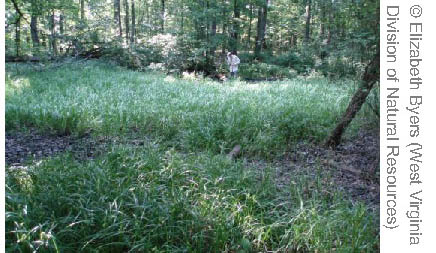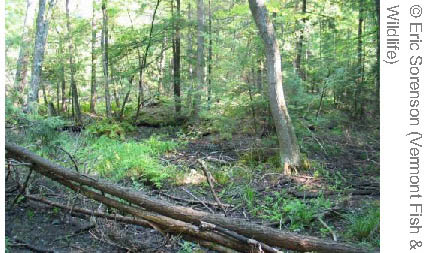The Central hardwood swamp macrogroup consists of the following habitats:
North-Central Interior Wet Flatwoods


Regional distribution:
CT, MA, ME, NH, NJ, NY, PA, RI, VT. 81,802 total acres of habitat, of which 7.5% is conserved.
Description:
A hardwood forest of upland and wetland species occurring in depressions or poorly drained lowlands throughout the northern glaciated Midwest and Lower New England. Pin oak dominates in many areas; other common (sometimes dominant) trees include swamp white oak, bur oak, black gum, sweet gum, and red maple. Areas with more dense tree cover have less shrub and herbaceous cover then the dense understory associated with more open canopies. Buttonbush, winterberry, and alder are typical shrubs; various sedges and cinnamon fern are common in the herb layer. Composition changes with fluctuating moisture levels. It is not known how modeled examples in coastal areas from New Jersey to southern Maine (light green) may differ from those in interior valleys and depressions (dark green).
Download the
pdf for this habitat for information about species, crosswalks to state names, and condition of this habitat.
Central Interior Highlands and Appalachian Sinkhole and Depression Pond


Regional distribution:
MD, NJ, PA, VA, WV. 1,458 total acres of habitat, of which 7.9% is conserved.
Description:
A small pond and wetland habitat with variable vegetation found in basins of sinkholes or other isolated depressions on uplands from the Ozarks east to the northern Piedmont. Water depth may vary greatly on a seasonal basis and may be a meter deep or more in the winter. Some examples become dry in the summer. Structure varies from open water to herb-dominated to shrub-dominated, where buttonbush is a typical component. Tree-dominated examples typically contain oaks, sycamore, green ash, silver maple, and/or black gum. Many of these ponds have their geologic origin as a more-or-less complete karst collapse feature.
Download the
pdf for this habitat for information about species, crosswalks to state names, and condition of this habitat.
Glacial Marine & Lake Wet Clayplain Forest


Regional distribution:
NY, VT. 88,168 total acres of habitat, of which 9.3% is conserved.
Description:
A wetland variant of the mesic clayplain forest system, and like that system dominated by a shifting mix of oaks and maples, a number of hardwood associates, and hemlock and white pine. The two types occur in a tight mosaic on the landscape. Swamp white oak, green ash, red maple, black ash, and musclewood tend to be more common in these forests due to the high water table. Moisture-loving sedges and wetland plants such as sensitive fern and water hemlock are characteristic. The shrub layer can be dense, and often includes non-native invasives like buckthorns, honeysuckles, and Japanese barberry. It is not known to what extent occurrences mapped in northwestern New York (light green) may differ in ecological character from those in the Champlain Valley (dark green).
Download the
pdf for this habitat for information about species, crosswalks to state names, and condition of this habitat.
Piedmont Upland Depression Swamp


Regional distribution:
MD, VA. 21,559 total acres of habitat, of which 4.7% is conserved.
Description:
A forested swamp of wetland oaks occurring in small, shallow basins in upland settings where water pools due to limited soil drainage. Most examples are isolated seasonally- flooded wetlands dominated by wetland oaks (pin oak, swamp white oak, laurel oak, willow oak, overcup oak), but a few are treeless or open-canopied ponds. Vegetation is zoned with an outer ring of trees, a more interior ring of shrubs (buttonbush, heaths, greenbrier), vines, and wetland graminoids and ferns, and a central area with or without standing water year round depending on precipitation. Sphagnum moss is sometimes extensive in parts of the pools.
Download the
pdf for this habitat for information about species, crosswalks to state names, and condition of this habitat.